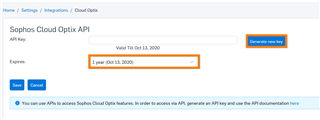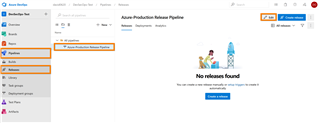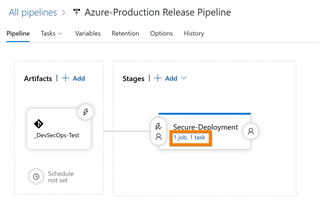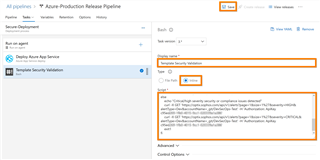Disclaimer: This information is provided as-is for the benefit of the Community. Please contact Sophos Professional Services if you require assistance with your specific environment.
Table of Contents
Overview
This recommended read covers using the new IaC template scanning API endpoint of Sophos Cloud Optix.
https://optix.sophos.com/apiDocumentation (In the "APIs for IaC Integration" section)
Pre-Requisites
- A Sophos Cloud Optix account
- An Azure DevOps account
Enabling API on your Sophos Cloud Optix Account
a. Go to https://optix.sophos.com/ and sign in with your credentials
b. Go to Settings → Integrations → Sophos Cloud Optix
c. Select the expiry time (6 months, one year, or Never), then click "Generate new key."
d. The API Key will be generated. Click "Save."
Add source control artifacts to the pipeline (Azure Repos, Git, etc)
- This needs to be done in Azure DevOps.
- This can be any repository that hosts your IaC templates (ARM, Terraform, and so on..)
- This can be for a build pipeline or a release pipeline. The example below uses a release pipeline.
- The example below shows how to add an Azure Repo for a release pipeline, but the same procedure will need to be followed for the source control you are using and the pipeline you’re configuring.
a. In Azure DevOps, go to "Azure DevOps → Pipelines → Releases → Select Pipeline → Edit → Add Artifacts"
- Source Type: Azure Repos
- Project: DevSecOps-Test (This will be your Azure DevOps project name)
- Source (Repository): AzureDeployment-Prod (This will be the name of your repository)
- Default Branch: Master (This will be the branch that you are using for the pipeline that this is being configured for)
- Default Version: Latest from the default branch (This will be the version that you want to reference in this pipeline)
- Source Alias: _AzureDeployment-Prod (This is the alias that will be used for the directory where the repo will be downloaded on the agent that will be running the tasks. You will be referencing this in your API call to CLoud Optix)
Add the Cloud Optix Security and Compliance task to one of your pipeline stages
- This needs to be done in Azure DevOps.
- This can be for a build pipeline or a release pipeline. The example below uses a release pipeline.
a. In Azure DevOps, go to "Azure DevOps → Pipelines → Releases → Select Pipeline → Edit"
b. Click on the stage that you want to add the IaC template security/compliance validation task to
c. Click "+" to add a new task, search for "bash", then select the "Bash" task
d. Select the task and edit the following
- Display Name: Template Security Validation
- Type: Inline
- Script: Add the sample script content below but edit with the right parameters
- ApiKey: Ensure that you put in your API key
- repo_url: This is the environment name that will be displayed in CLoud Optix if the result is saved
- files: Ensure that this is prefixed with the alias name of your Repo name that you defined in the pipeline artifact
- Click "Save" (top right corner)
# Scan for any high severity security and compliance issueshighalerts=$(curl "https://optix.sophos.com/api/v1/iac/scan" -H "Authorization: ApiKey c95ed269-xxxx-xxxx-xxxx-xxxxxxxxxxxxxx" -F "repo_url=https://david0620@dev.azure.com/david0620/DevSecOps-Test/_git/DevSecOps-Test" -F "committer_name=DavidOkeyode" -F "committer_email=optixworkshop0919@outlook.com" -F "branch=master" '-F files=@_AzureDeployment-Prod/cloud-optix-demo.json' -F "async=false" | jq '.summary.num_high_alerts'); # Scan for any critical severity security and compliance issuescriticalalerts=$(curl "https://optix.sophos.com/api/v1/iac/scan" -H "Authorization: ApiKey c95ed269-xxxx-xxxx-xxxx-xxxxxxxxxxxxxx" -F "repo_url=https://david0620@dev.azure.com/david0620/DevSecOps-Test/_git/DevSecOps-Test" -F "committer_name=DavidOkeyode" -F "committer_email=optixworkshop0919@outlook.com" -F "branch=master" '-F files=@_AzureDeployment-Prod/cloud-optix-demo.json' -F "async=false" | jq '.summary.num_critical_alerts'); # Stop the pipeline if there are any high or critical security or compliance issues detected# Also print out the issues detected if anyif [[ $highalerts == 0 ]] && [[ $criticalalerts == 0 ]]; then echo "No critical/high severity security or compliance issues was detected"else echo "Critical/high severity security or compliance issues detected" curl -X GET 'https://optix.sophos.com/api/v1/alerts?page=1&size=1%27&severity=HIGH&alertType=Dev&accountName=_git/DevSecOps-Test' -H 'Authorization: ApiKey c95ed269-xxxx-xxxx-xxxx-xxxxxxxxxxxxxx' | jq curl -X GET 'https://optix.sophos.com/api/v1/alerts?page=1&size=1%27&severity=CRITICAL&alertType=Dev&accountName=_git/DevSecOps-Test' -H 'Authorization: ApiKey c95ed269-xxxx-xxxx-xxxx-xxxxxxxxxxxxxx' | jq exit1fi |
e. Ensure that the task is dragged the main deployment tasks
- You can also select the agent that you want to run the task. I used "Ubuntu 16.04" in this example, but you can test with others also
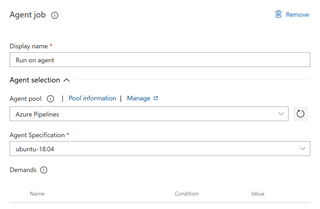
Testing the pipeline
a. In Azure DevOps, go to "Azure DevOps → Pipelines → Releases → Select Pipeline → Create release"
b. Look in the release logs for the output
- Click on the "Template Security Validation" task for full details
- The alerts detected can also be viewed in the Cloud Optix console (this is saved by default but can be modified using a parameter)
Revamped RR
[edited by: Erick Jan at 5:42 AM (GMT -7) on 18 Apr 2024]



